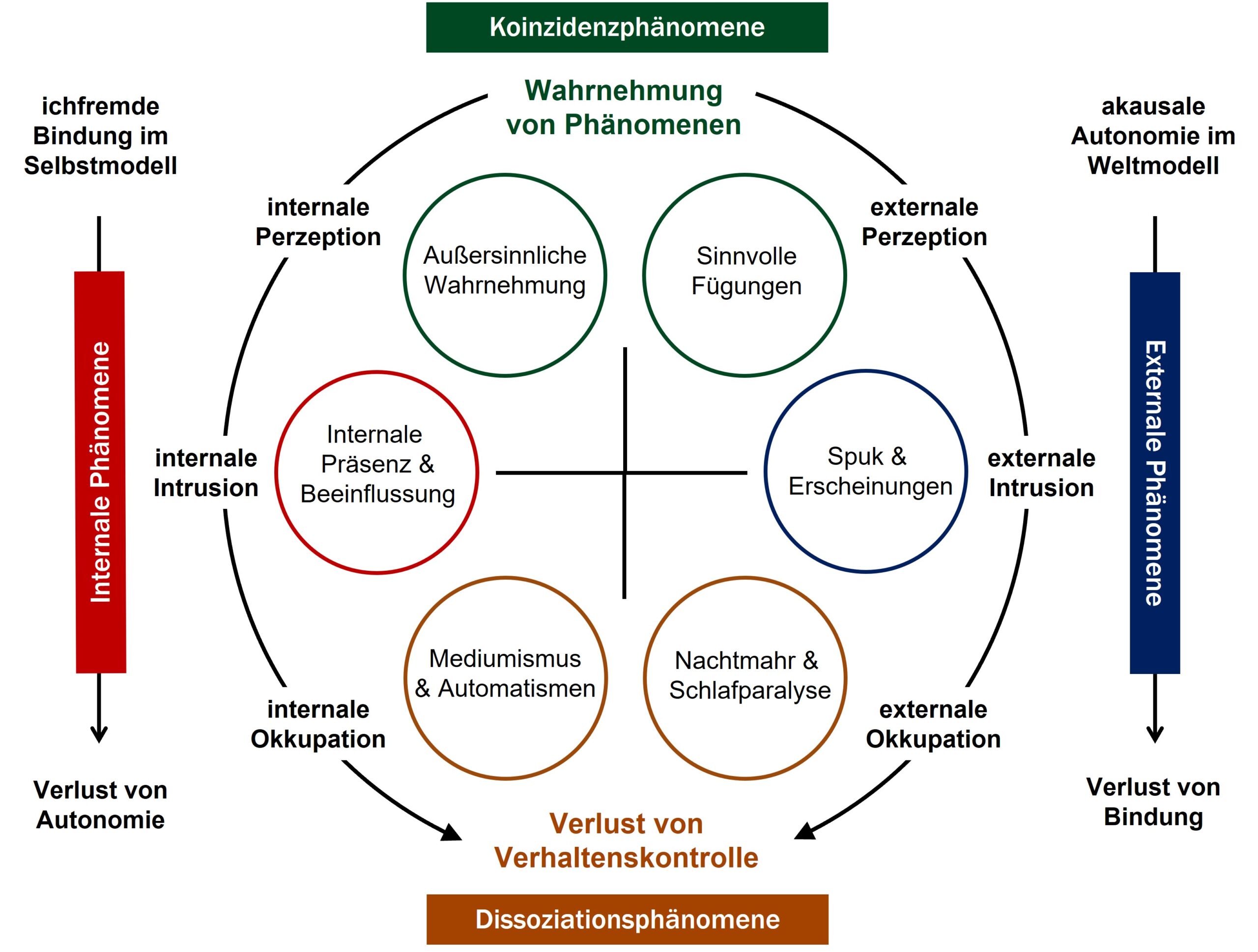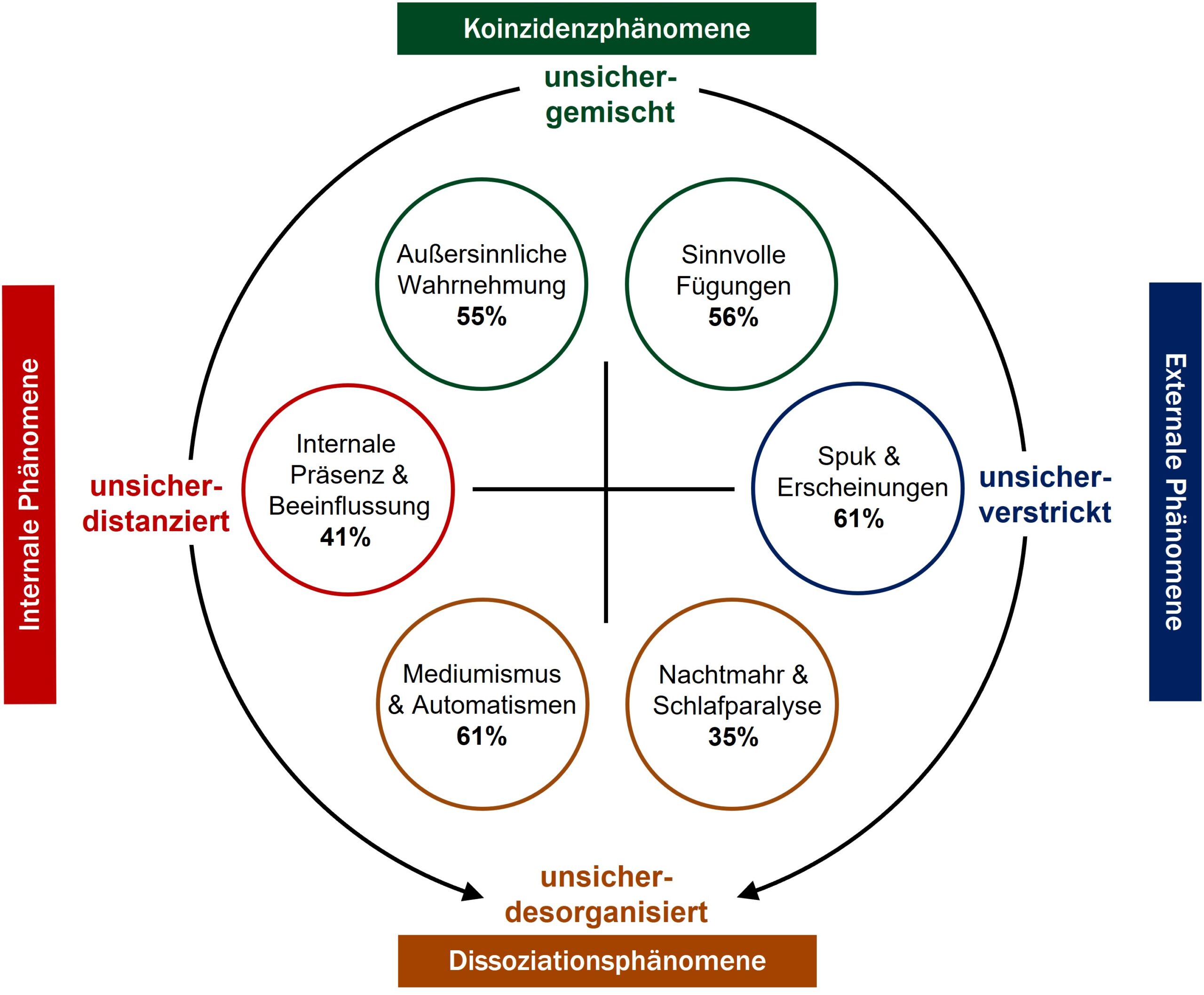As shown in Figure 1, the six typical ExE-patterns in IGPP counseling form a phenomenological spectrum of two continua, in which initially purely perceptual phenomena develop into intrusive internal or external phenomena in subsequent patterns, which at their extreme, take over behavioral control and lead to psychophysical dissociations. The two continua correspond phenomenologically with specific deviations from autonomy and bonding. Internally, the phenomena begin with extrasensory perceptions (ESP) and lead via internal presence and influences (IPR) to mediumship and automatisms (MED). In the case of external phenomena, the development proceeds from meaningful coincicences (MCO) via poltergeist and apparitions (PGA) to nightmare and sleep paralysis (NMS). At the stage of full occupation, internal phenomena result in a loss of autonomy (automatisms). External phenomena ultimately end in a loss of bonding (paralysis).
Parapsychology and Paranormal Phenomena
Statistical analyses of more than 2,300 documented counseling cases show that those seeking advice differ significantly in terms of their social bonding (partnership, marital status, housing situation, etc.) depending on the ExE patterns they report (Fach, 2022, 2024). The highly significant (p <.001) differences with regard to steady partnership/marriage are particularly striking: on the internal continuum, the proportion of clients in partnership/marriage falls from 55% (ESP) to 41% (IPR), and then rises to 61% (MED). In the external continuum, the proportion of those seeking advice in marriage/partnership rises from 56% (MCO) to 61% (PGA) and then falls to 35% (NMS). Against this background and based on biographical analyses and empirical data and knowledge from counseling practice, we assume that clients with ExE are characterized by insecure bonding styles. People with a secure bonding style can satisfy their basic needs for autonomy and bonding well. Negative attachment experiences, particularly in early childhood, can develop into insecure bonding styles. The attachment research describes two basic variants: People with a dismissing style avoid bonding because they perceive it as a threat to their autonomy; conversely, people with an enmeshed style avoid autonomy because they fear it might lead to a loss of bonding. Both behavioral components often occur in a mixed but organized style. People in crisis situations can fall into a disorganized style, particularly if they have experienced severe trauma and loss in early childhood.
Clinical Parapsychology and attachment research: Attachment Styles in Extraordinary Experiences
Lecture by Wolfgang Fach on 23.01.2024 at the colloquium of the IGPP
As shown in Figure 2, the findings to date suggest a mixed bonding style for coincident phenomena (ESP, MCO), a dismissing style for internal phenomena (IPR) and an enmenshed style for external phenomena (PGA). The fact that the social bonding of those seeking advice with dissociative phenomena (MED, NMS) contradicts the the bonding styles of those clients with the preceding ExE-patterns indicates a disorganized bonding style. This could result from the fact that the current life situation is not compatible withtheir genuine bonding style: In the case of the MED type, it conflicts with the need for autonomy while the autonomy in case of the NMS type is incompatible with the need for bonding.
In order to to investigate the hypothetical correlations, a pilot study with 30 clients is planned, with five clients representing each of the six ExE-patterns. They will be interviewed using German Version of the “Adult Attachment Prototype Rating” (AAPR). The AAPR is a standardized interview that explores bonding experiences from childhood to the current relationship situation. The interviews are conducted by four members of the counseling team who have completed certified training in the AAPR interview and its evaluation. The interviews last approximately 90 minutes and are video-recorded. Based on the recordings, the bonding styles will be independently assessed by two raters using a specialized coding system. Various questionnaires are used in advance of the interviews to investigate correlations between bonding styles, ExE, and other personality traits.
Project Team
Publications
Fach, W. (2022). Exceptional Experiences (ExE) and bonding styles: Autonomy and bonding as basic human needs and as structural determinants of ExE. Psychotherapy Section Review(67), 12-41. https://doi.org/10.53841/bpspsr.2022.1.67.12
Fach, W. (2024). The Spectrum of the Extraordinary. Conceptual approaches, empirical-phenomenological investigations and plan-analytical case studies on mental representation in extraordinary experiences [Dissertation]. University of Bern. https://boristheses.unibe.ch/5179/





